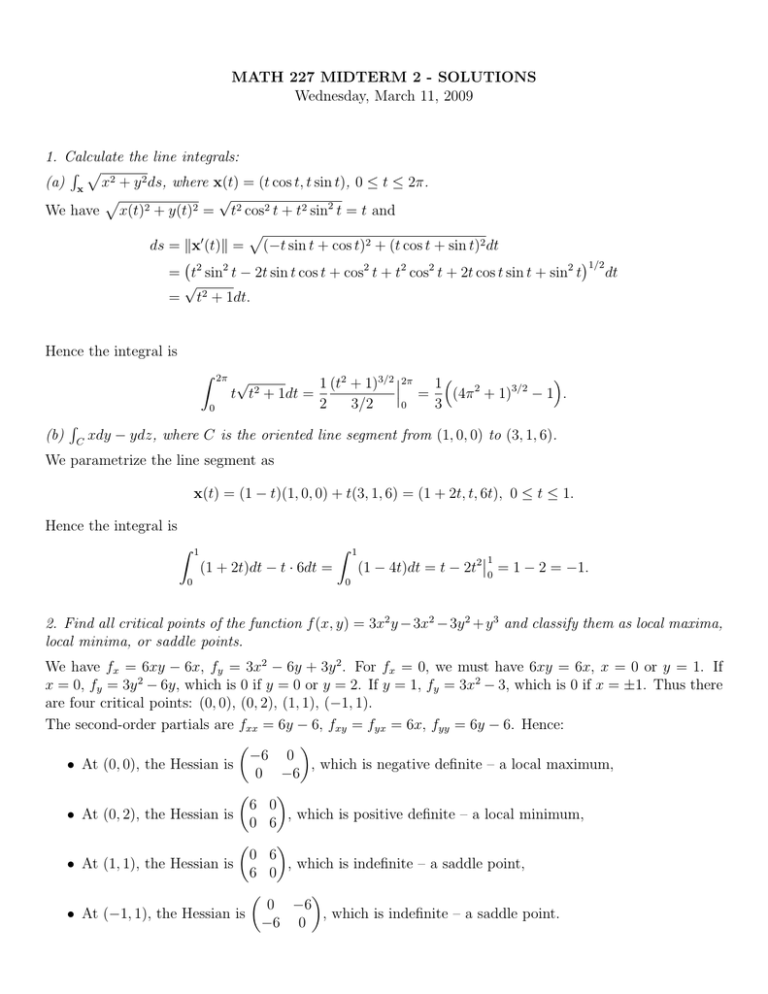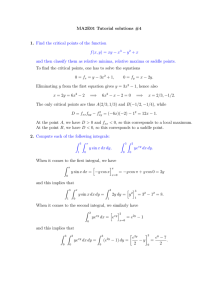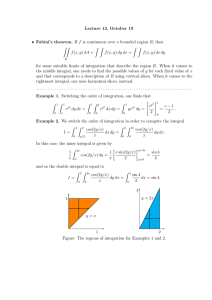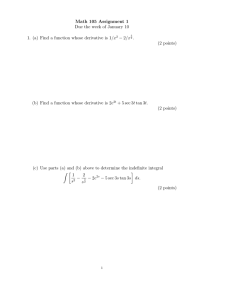MATH 227 MIDTERM 2 - SOLUTIONS Wednesday, March 11, 2009 px
advertisement

MATH 227 MIDTERM 2 - SOLUTIONS
Wednesday, March 11, 2009
1. Calculate the line integrals:
R p
(a) x x2 + y 2 ds, where x(t) = (t cos t, t sin t), 0 ≤ t ≤ 2π.
√
p
We have x(t)2 + y(t)2 = t2 cos2 t + t2 sin2 t = t and
p
ds = kx0 (t)k = (−t sin t + cos t)2 + (t cos t + sin t)2 dt
1/2
= t2 sin2 t − 2t sin t cos t + cos2 t + t2 cos2 t + 2t cos t sin t + sin2 t
dt
√
= t2 + 1dt.
Hence the integral is
Z
0
(b)
R
C
2π
√
1 (t2 + 1)3/2 2π 1 2
2
t t + 1dt =
(4π + 1)3/2 − 1 .
=
2
3/2
3
0
xdy − ydz, where C is the oriented line segment from (1, 0, 0) to (3, 1, 6).
We parametrize the line segment as
x(t) = (1 − t)(1, 0, 0) + t(3, 1, 6) = (1 + 2t, t, 6t), 0 ≤ t ≤ 1.
Hence the integral is
Z
1
Z
(1 + 2t)dt − t · 6dt =
0
0
1
1
(1 − 4t)dt = t − 2t2 0 = 1 − 2 = −1.
2. Find all critical points of the function f (x, y) = 3x2 y − 3x2 − 3y 2 + y 3 and classify them as local maxima,
local minima, or saddle points.
We have fx = 6xy − 6x, fy = 3x2 − 6y + 3y 2 . For fx = 0, we must have 6xy = 6x, x = 0 or y = 1. If
x = 0, fy = 3y 2 − 6y, which is 0 if y = 0 or y = 2. If y = 1, fy = 3x2 − 3, which is 0 if x = ±1. Thus there
are four critical points: (0, 0), (0, 2), (1, 1), (−1, 1).
The second-order partials are fxx = 6y − 6, fxy = fyx = 6x, fyy = 6y − 6. Hence:
−6 0
• At (0, 0), the Hessian is
, which is negative definite – a local maximum,
0 −6
6 0
• At (0, 2), the Hessian is
, which is positive definite – a local minimum,
0 6
0 6
• At (1, 1), the Hessian is
, which is indefinite – a saddle point,
6 0
0 −6
• At (−1, 1), the Hessian is
, which is indefinite – a saddle point.
−6 0
3. Use Lagrange multipliers to find the maximum and minimum values of the function f (x, y, z) = x −
2y + 4z on the surface x2 + y 2 + 2z 2 = 4.
We have ∇f = (1, −2, 4) and ∇g = (2x, 2y, 4z). Solve ∇f = λ∇g: 2λx = 1, 2λy = −2, 4λz = 4, hence
1
1
1
, y = − ,z = .
2λ
λ
λ
Plugging this into the equation of the surface we get
x=
4 = x2 + y 2 + 2z 2 =
hence
1
2
1+4+8
13
1
+ 2+ 2 =
= 2,
2
2
4λ
λ
λ
4λ
4λ
√
13
4
4
13
2
λ = , λ=±
, x = ±√ , y = ∓√ , z = ±√ .
16
4
13
13
13
2
We have
√
2
4
4
2
8
16
26
f ( √ , − √ , √ ) = √ + √ + √ = √ = 2 13,
13
13 13
13
13
13
13
√
4
4
2
8
16
26
2
f (− √ , √ , − √ ) = − √ − √ − √ = − √ = −2 13,
13 13
13
13
13
13
13
of which the former is the maximum value and the latter is the minimum value.
RR
4. If f (x, y) ≥ 0, we can define the improper integral R2 f (x, y)dA as
ZZ
ZZ
f (x, y)dxdy,
f (x, y)dA = lim
R2
R→∞
DR
where DR is the disk {(x, y) : x2 + y 2 ≤ R2 }.
RR
(a) (6 marks) Find all values of a ∈ R for which the integral R2 (1 + x2 + y 2 )a dA is finite, and evaluate
it for such a.
R 2π R ∞
In polar coordinates, the above integral is 0 0 (1 + r2 )a rdrdθ. If a 6= −1, this is equal to
1 (1 + r2 )a+1 ∞
π
2π ·
( lim (1 + R2 )a+1 − 1).
=
2 a+1
a + 1 R→∞
0
If a > −1, the above limit is infinite and so is the improper integral in (a). If a < −1, the limit is 0 and
−π
the improper integral equals a+1
.
If a = −1, we have
Z Z
2π
∞
(1 + r2 )−1 rdrdθ = π ln(1 + r2 )|∞
0 = ∞.
0
0
RR
(b) Prove that for a as in (a), the integral R2 (1 + x2 + y 2 )a (1 + sin(x2 ))dA is also finite.
We have 0 ≤ 1 + sin(x2 ) ≤ 2, hence
ZZ
ZZ
2
2 a
2
0≤
(1 + x + y ) (1 + sin(x ))dA ≤ 2
(1 + x2 + y 2 )a dA.
R2
R2
If the latter integral is finite, so is the former.
Note that the question did not call for a proof that the limit exists.
RR That can be proved as follows: suppose
that a < −1, so that the integral in (a) is finite, and let Fa (R) = DR (1 + x2 + y 2 )a (1 + sin(x2 ))dA. On the
one hand, since the integrand is non-negative, Fa (R) is an increasing function of R. On the other hand,
2π
Fa (R) ≤ − a+1
. Hence Fa (R) has a finite limit as R → ∞.
RR
5. Use an appropriate change of variables to evaluate the integral D (x − y)dxdy, where D is the region
in the first quadrant bounded by the hyperbolas x2 − y 2 = 1, x2 − y 2 = 4, and the lines x + y = 3, x + y = 6.
Let u = x2 − y 2 , v = x + y, then the region of integration is 1 ≤ u ≤ 4, 3 ≤ v ≤ 6. Also, x − y = u/v,
x = 21 (v + uv ), y = 12 (v − uv ). In particular, this proves that the inverse transformation is well defined for
v 6= 0, so that the transformation is one-to-one on the region in question. We compute the Jacobian:
∂(x, y)
1
∂(u, v) 2x −2y = 2x + 2y = 2v,
=
= .
1
1
∂(x, y)
∂(u, v)
2v
∂(x,y)
(Alternatively, one can compute ∂(u,v)
directly. This leads to a slightly longer computation, but is equally
correct.)
Thus our integral is
Z 4Z 6
Z 4
Z 4Z 6
Z 4 u
−u 6
u 1 1
u 1
du
=
· dvdu =
dvdu
=
−
du
2
6
1
3 2v
1 2v v=3
1 2 3
1
3 v 2v
Z 4
u2 4 15
5
u
du = =
= .
=
24 1 24
8
1 12






